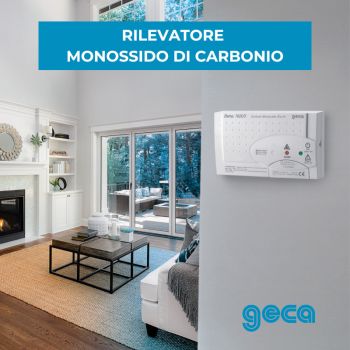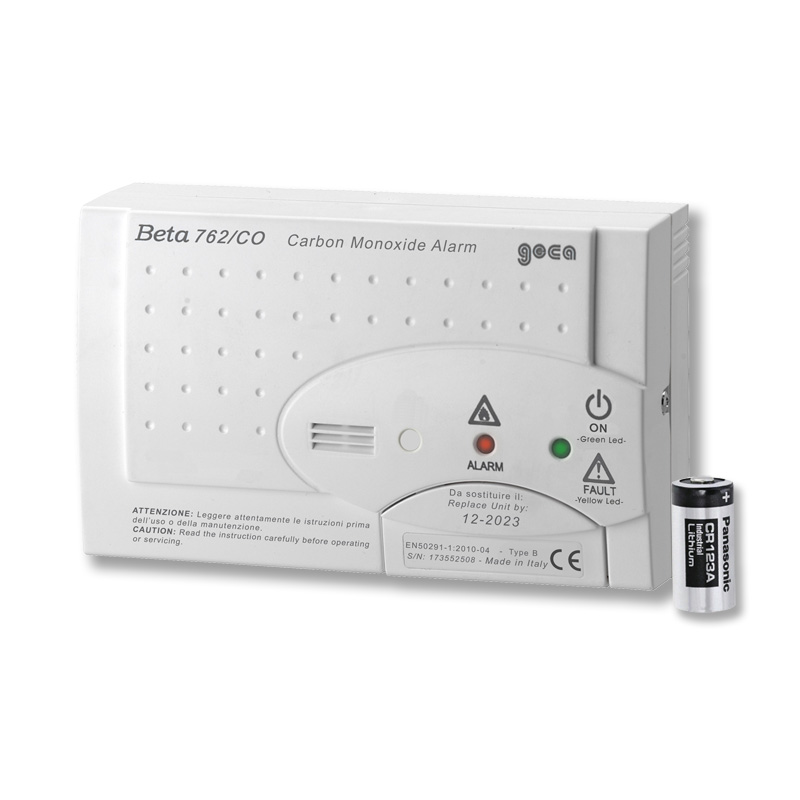Carbon monoxide detector: safety first
26 February 2024
There is an invisible enemy that threatens our health and safety at home: carbon monoxide. It is a silent danger, the main cause of poisoning (even deadly) within the home.
Against this threat, since January 2024 it has become obligatory to equip all housing for short or tourist rent with a carbon monoxide detector. This is to protect human lives from an often underestimated danger.
Carbon monoxide detector: why it is important
Carbon monoxide is a gas produced by incomplete combustion of gas, wood or coal. It is released from boilers, stoves, fireplaces, malfunctioning gas stoves and can cause serious intoxication, until death.
He is a silent killer because completely imperceptible (odorless and invisible) and poisons people without them noticing.
Good practice is a valuable help in reducing risk. For example, ventilating rooms well and not leaving functioning appliances unattended (for example, turning off the wood or gas stove before going to bed) are healthy habits that should always be adopted.
Other tips to prevent serious accidents to people’s health are those of:
- ensure that the flues and ventilation systems are up to standard and function properly;
- do not use gas cookers to heat the environment;
- have the installations periodically checked by qualified personnel.
But the CO detector is the only really effective and safe way to notice the presence of monoxide in time and get to safety by airing the rooms and getting out in the open air.
What carbon monoxide detectors are and how they work
These are life-saving devices that, through a special sensor, monitor the concentration of CO in the air.
When the level of carbon monoxide exceeds a preset threshold, the sensor triggers an audible and visual alarm to warn the present of danger.
Carbon monoxide sensor: electrochemical or semiconductor?
There are two main types of sensors: electrochemical cell and semiconductor.
The former work thanks to a chemical reaction that occurs in the presence of CO gas. The reaction generates an electrical signal that is then translated into alarm.
The latter work by changing the conductivity of the semiconductor material in the presence of CO.
Electrochemical sensors are known to be more reliable and sensitive than cheaper semiconductor sensors. They are more accurate, stable over time and less affected by external factors, such as the presence of gases and other contaminants in the environment, so the risk of false alarms is minimized. In addition, the only maintenance required is their replacement at the end of life.
CO detectors: characteristics and quality
Installing a CO detector in your property is an important investment for your safety and that of those who live there. Especially since it is now mandatory if you intend to allocate your accommodation to a short or tourist lease.
But since these are life-saving devices, the choice should fall on a product with certain quality characteristics in order to ensure the safety you seek.
- The sensor: opt for a detector with reliable sensors such as electrochemical ones, which guarantee accuracy, sensitivity, stability over time and durability.
- Certifications and conformity: the detector must comply with the European standard EN 50291-1:2010.
- Alarm: it must be both acoustic and optical, so that even an elderly person or with disabilities can warn him.
- Brand historicity: it’s not just a question of reputation. A long-standing brand on the market such as Geca (which has been active in the home security sector for 30 years) is the best guarantee of an uncompromising after-sales service: means that it is a solid and reliable company and therefore you can always count on timely and careful assistance.
- Installation: the quality of a detector is also measured by its ease of installation, use and maintenance. Geca’s carbon monoxide detectors, which must be installed and positioned in accordance with UNI 11522, do not require periodic checks or maintenance and must be replaced at the expiry indicated on the product.
- Functionality:in addition to a good optical and acoustic alarm, it is important that the detector is equipped with the self-test with which the device makes a periodic self-monitoring to detect and report any faults or anomalies. In addition, it must warn the user when the product reaches the end of life and it is necessary to replace it.
Carbon monoxide alarm: battery operated or connected to the network?
The choice between a battery-powered or mains-connected carbon monoxide detector depends on your specific needs, context and personal preferences.
A battery detector has the advantage of being quick and easy to install. It does not need wiring of electrical wires and therefore can be installed anywhere, even if there are no sockets nearby; is portable and can be moved to another room, as long as it complies with the regulations. It also works in the event of a blackout. In the case of the Betadi Geca detector , you don’t even have to worry about replacing the battery: its life, in fact, is guaranteed 6 years, when the electrochemical cell sensor reaches the end of life and must still be replaced.
A detector connected to the mains has the disadvantage of needing a power cord and not being able to operate in case of a blackout (if not equipped with buffer power), but has the advantage of incorporating a relay that allows, in the event of an alarm, activate an aeration or ventilation device autonomously.
Consider, however, that even a detector connected to the mains - as well as the battery - needs to be replaced when it reaches the end of life (Geca products guarantee over 6 years of service life).
Where to place carbon monoxide sensors
The positioning criteria of the CO detectors are dictated by the European standard EN 50292 that provides precise requirements depending on whether there are combustion appliances in the room (gas stove, fireplace, stove) or not (for example bedroom, corridor etc.).
In addition, it is important to avoid placing the device avoiding obstacles, in closed rooms where there is no air exchange, on damp walls.
In any case, since they are life-saving devices, it is a good rule to let qualified personnel install them, who issue a certificate of conformity at the end of the work. Even more so if electrical connections are needed.
A non-professional installation, in fact, can alter the performance of the detector and frustrate safety.
Why rely on Geca for safety
Geca offers a wide range of carbon monoxide detectors, with different characteristics and price ranges. For the domestic sector Beta 762 CO is a latest generation battery detector, compliant with the European standard EN 50291-1:2010 and guarantees for over 6 years the operation of the battery and sensors. Every 10 minutes it performs a self-test: the device automatically checks that all components, including the sensor, are efficient and in case of anomalies emits an alert signal.
Geca is an Italian company active for over 30 years in the security sector. Manufactures and tests the products in its factories in Lombardy. For this reason, prompt delivery and immediate availability of spare parts are always guaranteed.
Do not risk your life and that of your guests: choose Beta di Geca.

 EN
EN  IT
IT  FR
FR 
